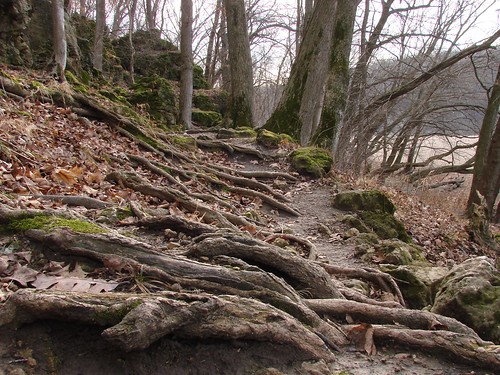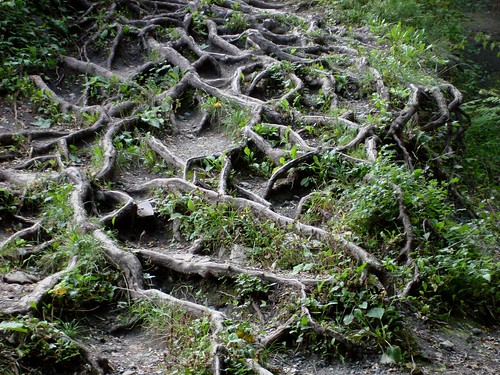 Wherefore lift up the hands that hang down, and the palsied knees; and make straight paths for your feet, that that which is lame be not turned out of the way, but rather be healed. Follow after peace with all men, and the sanctification without which no man shall see the Lord: looking carefully lest there be any man that falleth short of the grace of God; lest any root of bitterness springing up trouble you, and thereby the many be defiled. (Hebrews 12:12-15 ASV)
Wherefore lift up the hands that hang down, and the palsied knees; and make straight paths for your feet, that that which is lame be not turned out of the way, but rather be healed. Follow after peace with all men, and the sanctification without which no man shall see the Lord: looking carefully lest there be any man that falleth short of the grace of God; lest any root of bitterness springing up trouble you, and thereby the many be defiled. (Hebrews 12:12-15 ASV) Therefore, strengthen the hands that are weak and the knees that are feeble... (Hebrews 12:12 NAS95)
I was a little baffled by the translation that I study from, the NAS95 quoted last here, until I looked up the original as well as a number of other translations. I believe from looking at all of these that the ASV best describes what the original intent of the text was, especially for verse 12. It also has strong implications of reference to parallel verses in Isaiah that I believe this alludes to. Particularly I think these apply: Isaiah 40:1-11; 42:16 and all of chapter 61.
One of my initial questions is, why does it specifically mention hands and knees?
Lifting hands implies worship and looking to God for strength. If the hands are hanging limp then it may mean that there is discouragement going on and a lack of focusing on Jesus. Most likely if the hands are hanging limp then the head may be hanging down along with them.
What I find when looking at the Greek and even some of the English translations is an implication of lifting up the knees as well as the hangd implying walking, setting out, beginning to move. Putting these two ideas together creates a picture of a person who is simply standing around feeling tired, who has lost heart (v. 3) or grown faint from the unexplainable trials that seem to be plaguing them for no good reason (v. 5-11) The do not realize that their condition of being static in their growth and experience is because they have forgotten the exhortation addressed to them as sons about these experiences (v. 5) and they are not focusing on Jesus (v. 2). Consequently they are standing still on an apparently very rough path that is too difficult and tiring to continue on and are feeling very stuck. (Hey, this is starting to feel all too real and personal.)
Then the text addresses the need for better paths so the weak knees are not twisted by uneven ground. I have many times walked on very rough ground, sometime when hiking on rough terrain and sometimes when working on rough areas planting trees on land that had not been cleared very well. I know the intense frustration of feeling like it took a lot of effort to not make very much progress. I also know that it is not very hard to end up twisting an ankle or even a knee if not being very careful while trying to navigate such terrain. In addition, if I am not in very good physical shape the danger of turning a joint is even greater.
One of the most annoying obstacles and dangers for twisting an ankle or knee is roots that get in the way. They are much worse than fallen sticks because they are anchored into the ground and will not move out of the way when hit with your foot or leg. Consequently they become much more likely to be an occasion for stumbling than most other obstacles. If your foot gets caught underneath one and you can't catch yourself quick enough it can cause serious injury. I can certainly see how roots of bitterness can be a similar cause for problems in my spiritual and social life.
What is it that strengthens and tones up my legs and body so that this danger is lessened? Resistance training (v. 4) that comes from a graduated exercise routine and also learning from experience the coordination necessary to move carefully but swiftly across very rough land or even jumping boulders in canyon creeks.
What I see in this passage is not just an urging to lift up my hands and focus my attention more on God, but also to pick up my weak knees and start moving in some direction so that I will begin making at least some progress away from where I currently am. But in addition to that I also may need to spend some time helping repair the condition of the paths that are so rough for me, paying particular attention to removing the dangerous roots so that others will not be in so much danger of becoming hurt from the confusion and unevenness of the ground. As I help to make the paths straighter and smoother for my own feet I am also helping pave the roads so that others following me may make more efficient progress than what I have experienced. Maybe this hearkens back to 11:39, 40. Both those who go before and those who follow after work together in God's plan so that they all become interconnected with each other to be perfected in the faith of Jesus.
The reason given here for the straightening of the paths is not only to avoid dislocating a knee or twisting an ankle, which could definitely slow down or stop someone's progress, but for healing as well. Healing usually takes time and also therapy many times. It means not overstressing a damaged or weak muscle. My daughter is working in a physical therapy rehab center and tells us many stories of people coming in after operations or accidents and needing muscle and joint rehabilitation and healing. There is a science to this process that she is actually going to school right now to learn. And the same kind of science needs to be applied in our emotional and spiritual healing as well.
So just where is this path leading that needs to be leveled and straightened? What is the direction we are to begin moving while lifting up our limp hands and picking up our knees one after the other? I think maybe the next verse give us some instruction about this.
I see two things in verse 13 as reasons for needing to do all of the above. (1) Pursue peace with all men, and (2) pursue the sanctification without which no one will see the Lord. Evidently these two things are considered the main reasons for even participating in this whole operation, the goals of the path that we are choosing to travel with Jesus. I want to spend much more time exploring these two things later.
But most importantly mentioned here, our ultimate goal is to see God. That was the passionate plea of Moses on Mt. Sinai, he wanted to see God's glory, and it has been the underlying hunger of every heart born into this world whether they ever know it or not. Our heart was designed to be connected with God and will never really know full satisfaction with any substitute. Unfortunately many do settle for cheap counterfeits and think that those are the best that can be had. But God is not going to rest until everyone possible has been drawn into His original plan of intimacy with His own heart and they have become filled to overflowing with the immense joy and pleasures that He designed us for.
Then I will go back to my place until they admit their guilt. And they will seek my face; in their misery they will earnestly seek me. (Hosea 5:15 NIV)
If my people who are called by my name humble themselves, pray, seek my face, and turn from their wicked ways, then I will hear from heaven, and will forgive their sin and heal their land. (2 Chronicles 7:14 NRSV)
"Come," my heart says, "seek his face!" Your face, LORD, do I seek. (Psalms 27:8 NRSV)







No comments:
Post a Comment
Thank-you for leaving a comment. Let me know how you feel about what you are reading. This is where I share my personal thoughts and feelings about whatever I am studying in the Word at this time and I relish your input.